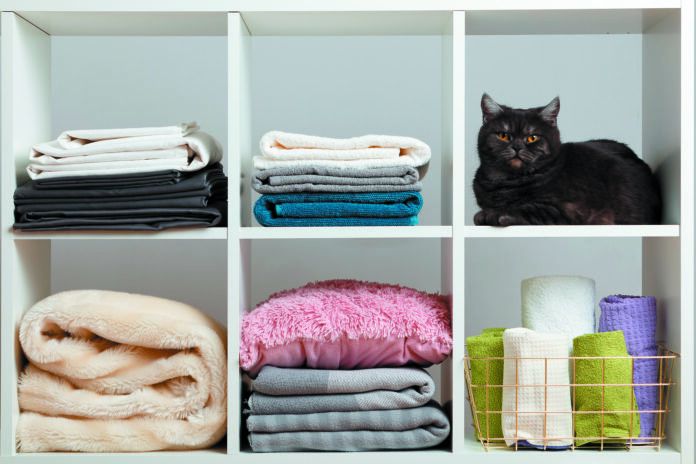The American Association of Feline Practitioners (AAFP) and the International Society of Feline Medicine (ISFM) speak of the “five pillars of a healthy feline environment.” Are these pillars up in your home?
Pillar 1. A safe place. “For a cat, says the AAFP and ISFM, “a safe place is a private and secure area, often in a raised
location.” That gives the cat a sense of enclosure, isolation, or seclusion, as well as a sense of protection. If a cat cannot see a potential threat, he feels safer, even if his body is not fully concealed. Consider that cats are solitary hunters who would prefer to avoid rather than confront perceived threats.
Pillar 2. Multiple and separated key environmental resources. Translation: Set up more than one spot in your home for feeding, drinking, toileting, claw scratching, play, and resting/sleeping. This is important not only for cats who live with other cats but also for “only” cats. You probably already know that a home with just one cat should have two litter boxes in different locations, and more than one spot for scratching and playing. Opportunities to eat and drink can also be set up in more than one location. This will decrease a cat’s stress, says the AAFP and ISFM, in addition to satisfying his natural need for exploration and exercise.
Pillar 3. Opportunity for play and predatory behavior. It’s not enough just to leave toys around. It’s incumbent on you to play with your cat and also to provide opportunities for him to hunt for his food so he can scratch his predatory itch, so to speak. “Predatory behavior occurs even in well-fed cats,” the AAFP and ISFM point out. “Failing to provide cats with opportunities for predatory-type behaviors can result in…boredom and frustration” that express themselves as over-grooming, stress-associated disease
(yes, cats can get sick if they are emotionally stressed), or misdirected aggressive behavior. With that in mind, hide food in different locations, and provide food puzzles that make a cat have to hunt or work for his food. And play games with your pet that make him interested in chasing after something. Rotate your cat’s toys, too, to keep life interesting.
Pillar 4. Positive, consistent and predictable human–cat social interaction. Your cat may not necessarily want a lot of interaction with you, but he does want it — regularly and predictably. You should never force interaction with a cat, but there are things you can do to make your pet feel more secure about hanging out with you. Lower yourself to your pet’s level, and avoid fixed eye contact. In other words, it’s okay to look at your cat, but don’t stare. If your cat seems game for physical connection, start by gently stroking his head and cheeks. Speaking gently helps, too. Each cat has his own individual preferences for being petted, played with, picked up, talked to, and sitting or laying on his owner’s lap. Learn your cat, and you and he will develop a stronger bond.
Pillar 5. An environment that respects the importance of the cat’s sense of smell. “Unlike humans,” the AAFP and ISFM point out, “cats use olfactory and chemical information to evaluate their surroundings and maximize their sense of security and comfort.” That is, we look and listen to orient ourselves to our environment and feel okay in it; they sniff. If their olfactory cues are thrown off in any way, they could end up eliminating inappropriately or scratching where they shouldn’t. With that in mind, don’t use cleaners, detergents, scented litter, or other products that might interfere with the scent profile a cat associates with his customary surroundings. Additionally, put footwear and shopping bags at the entrance to your home to avoid introducing external odors into the indoor environment. And wash your cat’s toys and bedding on a rotating basis so that at least some of his items will retain a familiar scent.




